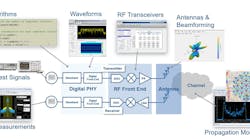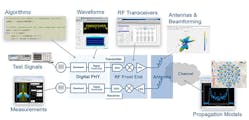MathWorks believes that the complexity of today’s wireless standards is creating serious challenges for engineering teams tasked with designing next-generation communications systems. Consider an environment in which multiple design teams are each working in separate disciplines like RF, antenna, analog, digital, software, and systems engineering. According to MathWorks, “designers from these varied and highly specialized engineering fields typically lack access to a single, sharable modeling platform. Instead, they resort to a patchwork of incompatible simulation and test tools that undermine team collaboration.”
Furthermore, MathWorks states, “The absence of a unified workflow leaves designers unable to efficiently simulate, test, verify, and validate their designs as early as required to meet shrinking deadlines and tight budgets. Separate teams now spend as much as 70% of their time testing and validating their designs using isolated toolsets. This creates redundancies that lead to costly inefficiencies and project delays. And with new wireless standards emerging—and existing standards constantly evolving—this problem is likely to worsen.”
So, how can MathWorks’ tools help to overcome these issues? Ken Karnofsky, senior strategist for signal processing and communications at MathWorks, said, “Our customers are often taking advantage of many aspects of our wireless tools. We have a number of products that support various wireless standards, which is an essential part of the solution.”
Product Flexibility
According to Karnofsky, different customers are using MathWorks products in different ways. “The designers who are creating the algorithms for the physical layer are using our tools at a very detailed level as a design reference. Other engineers, whether they’re RF engineers or test engineers, are mostly using the waveforms available in our tools to test models of their RF or antenna designs, or they’re using the waveforms in the lab once they have real hardware to be tested.
“Our quest in this market is to try to bridge those different worlds,” continued Karnofsky. “Over the last several years, we’ve done that by enhancing our capabilities not only for the wireless standards, but also for the RF and antenna design. That allows customers to validate their designs in different parts of the system in the same environment. This is really critical in this day and age, because it’s very difficult to design one component without considering the impact of the others. Once you have a validated model of the system, you can reuse the test bench and the models as a reference to produce tests that are used in the lab—either in a design validation or testing environment.”
Karnofsky also pointed out how MathWorks’ tools can interface directly with test equipment, offering significant advantages. “In the testing world, you can get very sophisticated conformance testing and over-the-air (OTA) testing capability from the RF test-and-measurement vendors. But we’ve seen that customers are finding they can save time by applying the waveforms and tests they’ve done in simulations with our tools, and then just connecting directly to those instruments and reusing what they’ve already done in simulations. That saves time by simplifying and speeding up the comparison of the actual results in the lab with the predicted results in the model.”
One way to validate some of the points brought up by Karnofsky is to highlight an actual customer use case. A Qualcomm division in the United Kingdom that develops RF front-end components for 5G systems used MATLAB to build a complete model of the transmit and receive paths. Included were fixed-point digital blocks and power-amplifier models. The team performed simulations to predict system performance measures, optimize design parameters, and automate testing over a range of waveform combinations. Furthermore, the team automatically generated C waveform libraries from the MATLAB 5G models, enabling the delivery of waveform generation to customers.


